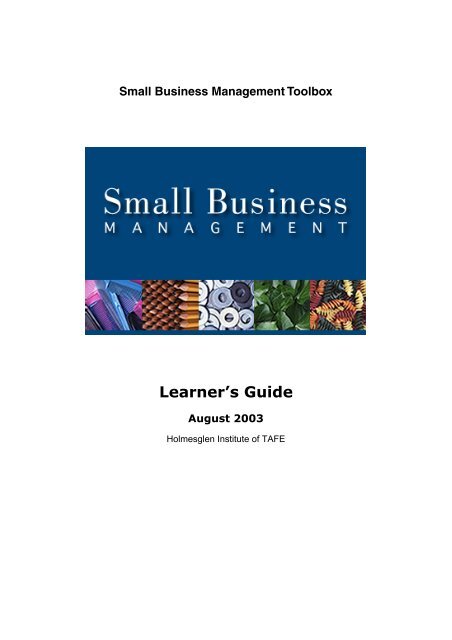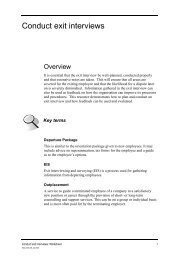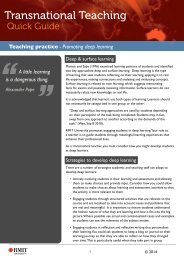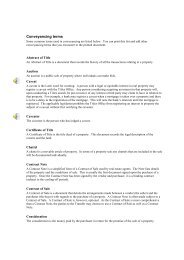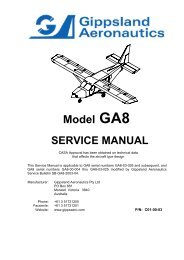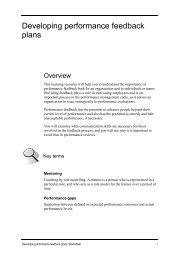Learner's Guide - Flexible Learning Toolboxes
Learner's Guide - Flexible Learning Toolboxes
Learner's Guide - Flexible Learning Toolboxes
You also want an ePaper? Increase the reach of your titles
YUMPU automatically turns print PDFs into web optimized ePapers that Google loves.
Small Business Management ToolboxLearner’s <strong>Guide</strong>August 2003Holmesglen Institute of TAFE
<strong>Learner's</strong> <strong>Guide</strong>AcknowledgmentsThe Small Business Management Toolbox was funded by ANTA and developed byHolmesglen Training and Development, Holmesglen Institute of TAFE.Project Director:Project Coordinator:Multimedia Manager:Instructional Design:Graphics:Multimedia:Administration:Joan SalmonChristine FoardTheo KavadiasAndrew Buntine, Evelyn Flitman, Marian Jaquiery,Bernadette McDermott, Bart ScheenPeter Joison, Eeleng KokTimage Abdulwadud, Adam Lemmo, Vlad Mezin,Geordie Oxley, Rowan PeterMelissa Jacobson, Fay Lehmann, Debbie MackinWe would like to thank all advisors, writers, technical editors and reviewers whocontributed to the development of this project. In particular we would like toacknowledge the following key groups for their contributions to this project:Steering Committee:Elaine Egan, Western Business Enterprise CentreZina Micelli, Business Services Training Australia LtdLen Alabaster, Box Hill Institute of TAFEAlan Daniel, Curriculum Maintenance Manager, BusinessServices Training PackageSusan Windsor, Rural Training Council of AustraliaShirley Smith, Swinburne University Business EnterpriseCentreGrace Falcon, Falcon ConsultingBrett Stavenuiter, Ballarat Adult & Further EducationCentre (BRACE) Inc.Sam Cook, Cooloola Sunshine Institute of TAFEWarren Colledge, Department of Employment andWorkplace Relations
<strong>Learner's</strong> <strong>Guide</strong>Industry Reviewers:Greater Western Chamber of CommerceKathy Butler, Info Research ServicesChristine Lockey, SafadeRuss Barty, HIS Hose Pty LtdJanice Simpson, Simpson Management Pty LtdAll information in this resource was current within the year of publication, but maysubsequently change. ANTA and Holmesglen Training and Development accept noresponsibility for subsequent changes or inaccurate information.© Australian National Training Authority (ANTA) 2003. All rights reserved. ii
<strong>Learner's</strong> <strong>Guide</strong>Table of contentsIntroduction.............................................................................................. 1What is a Toolbox?................................................................................. 1Technical requirements.......................................................................... 2The Small Business Management Toolbox .......................................... 3Overview................................................................................................. 3Navigation............................................................................................... 4Accessibility............................................................................................ 6Enlarging the text ................................................................................... 7Using the Toolbox components............................................................. 8Your task ................................................................................................ 8Topics..................................................................................................... 8Self tests................................................................................................. 9Activities ................................................................................................. 9Example businesses ............................................................................ 10References ........................................................................................... 11Details of the competencies................................................................. 12Coordinate implementation of customer service strategies ................. 12Develop work priorities ......................................................................... 16Establish business and legal requirements.......................................... 19Manage a small team ........................................................................... 22Manage finances .................................................................................. 25Monitor and manage business operations ........................................... 30Monitor a safe workplace ..................................................................... 34Promote the business........................................................................... 38Research business opportunities ......................................................... 42Undertake business planning............................................................... 45Undertake financial planning................................................................ 52
<strong>Learner's</strong> <strong>Guide</strong>IntroductionWelcome to the <strong>Learner's</strong> <strong>Guide</strong> for the Small Business Management Toolbox. Thisguide has been designed to help you use the Toolbox.The Small Business Management Toolbox is specifically designed to assist peopleworking in or planning to work in small businesses to acquire knowledge that iscritical to business development and sustainability. It is designed to provide smallbusiness owners and managers with a range of skills and competencies to enablethem to establish and grow their small business ventures.What is a Toolbox?A Toolbox is a collection of online training materials comprising learning activities,resources and user guides to support program delivery for endorsed TrainingPackage qualifications.The resources in the Toolbox are based on eleven competency standards from theBusiness Services Training Package BSB01.• BSBCMN402A Develop work priorities• BSBCMN410A Coordinate implemetation of customer service strategies• BSBCMN411A Monitor a safe workplace• BSBSBM301A Research business opportunities• BSBSBM401A Establish business and legal requirements• BSBSBM402A Undertake financial planning• BSBSBM403A Promote the business• BSBSBM404A Undertake business planning• BSBSBM405A Monitor and manage business operations• BSBSBM406A Manage finances• BSBSBM407A Manage a small teamDetails of these competency standards are available at the National TrainingInformation Service website .In this site, select 'Competency standards' , then click on the radio button 'Unit ofcompetency', and type in either a keyword from the title of the compentency (eg'research business') or the competency code (eg BSBSBM301A).© Australian National Training Authority (ANTA) 2003. All rights reserved. 1
<strong>Learner's</strong> <strong>Guide</strong>Technical requirementsThe minimum hardware requirements for running this Toolbox are as follows.• IBM compatible computer with a 300 MHz processor• 64 MB of SDRAM• 800 x 600 16-bit display (1024 x 768 recommended)• Minimum 60 MB of hard disk free• CD-ROM drive• 28.8 K modemOR• Macintosh equivalent.You will also need to have access to the following software to use the product.• Internet Explorer version 5 or Netscape Navigator version 4.7 or higher• Adobe Acrobat Reader - version 4 or higher (available from www.adobe.com)• Macromedia Flash Player - version 5 or higher (available fromwww.macromedia.com)The resources in this Toolbox have been tested to comply with W3C WebAccessibility Initiative Priority 1 standards.© Australian National Training Authority (ANTA) 2003. All rights reserved. 2
<strong>Learner's</strong> <strong>Guide</strong>The Small Business Management ToolboxOverviewEach of the competency standards covered by the Small Business ManagementToolbox presents the following set of resources.Your taskTopicsSelf testsActivitiesExamplebusinessesReferencesAn overriding activity, requiring you to apply knowledge andskills associated with the competency.Individual content areas dealing with specific aspects of thecompetency.Short quizzes targeted at each topic that allow you to measureyour current understanding.Opportunities for you to apply knowledge contained within topicsand develop skills in various aspects of small businessmanagement.Hypothetical businesses that you may wish to use for applyingconcepts and principles outlined in the topics, particularly if youdo not currently run a business of your own.Additional sources of information such as books and websites.A quick reference guide to business terms is also included.Section 3 of this guide examines these features in more detail and suggests sometips for using each in a learning strategy.© Australian National Training Authority (ANTA) 2003. All rights reserved. 3
<strong>Learner's</strong> <strong>Guide</strong>NavigationThe Toolbox has been designed to ensure that navigation is as simple as possible.The following features have been included to assist movement around and betweenthe resources.The competencies screen is the first page that you see when accessing the Toolbox(ie the 'home page'). This screen provides access to each of the elevencompetencies and a link to a page of useful tips for first time users.First time userClick here for navigation tips andgeneral information about thedifferent resources available.Competency listClick an item to select acompetency standard.© Australian National Training Authority (ANTA) 2003. All rights reserved. 4
<strong>Learner's</strong> <strong>Guide</strong>Within each competency, all similar resources (topics, activities, self tests etc) aregrouped together in separate sections, which are accessible via the top navigationbar.Use the features at the side of the top navigation bar to access the following.• The <strong>Learner's</strong> <strong>Guide</strong>.• The Home page (to view another competency).• A list of Contents for the competency. This list of all relevant resources andprovides single-click access to every resource within the competency.• A link to a Discussion board or chat session. This feature will only beavailable if your trainer has arranged for it to be set up.A 'breadcrumb' feature has been included immediately below the navigation bar oneach screen. This indicates the position of the current screen within previousresource levels of the Toolbox. In the example shown below, the topic 'Staff plans'has several subtopics. The subtopic of the current page is 'Job descriptions'. Eachlevel of this breadcrumb can be clicked, providing a shortcut back to a specificpreceding section of the resource.'Breadcrumb'© Australian National Training Authority (ANTA) 2003. All rights reserved. 5
<strong>Learner's</strong> <strong>Guide</strong>Callout boxes on the right side of each screen indicate relationships betweenresources. For example, a callout box within a particular topic will direct you toactivities or downloads pertaining to the specific content covered.AccessibilityThe Small Business Management Toolbox has been designed to comply withaccessibility standards, thus allowing learners with physical or learning disabilities orspecial literacy needs to use the online resources. For example:• literacy needs for second language learners or those with low literacy levelshave been catered for by using Plain English guidelines• layout and fonts have taken into account the needs of screen-readers for theblind and visually impaired.• visual images including Flash devices used for presentation of text, quizzesand interactive activities have alternative text provided describing and/orreproducing what they include.NOTE: The Toolbox has been designed for learners studying competencies atCertificate IV level. These competencies require a certain level of language literacyappropriate to subject-specific vocabulary.© Australian National Training Authority (ANTA) 2003. All rights reserved. 6
<strong>Learner's</strong> <strong>Guide</strong>Using the Toolbox componentsThe structure of resources within this Toolbox is consistent across each of the 11competency standards.This section describes each of these components.Your taskWhen you access a competency, you are initially presented with a task requiring youto apply the knowledge and skills associated with the competency to a smallbusiness. You may choose to apply the task to your own business, another that youcan access or one of the 'Example businesses' provided within the Toolbox (seebelow for more information).TopicsThe content of each competency is provided within several topics, which address aparticular aspect of the work involved.This structure allows for easier navigation throughout the resource, providing quickaccess to particular areas of relevance or interest.Topics also emphasize particular points of relevance through the use of twoadditional features.• Case studies demonstrate the practical applications or implications oftheories and concepts presented in topics.• Mentors provide additional information to learners about particular aspects ofa topic. A particular character is used as the mentor in each competencystandard, in order to provide an appropriately personable voice. For example,the mentor in 'Monitor a safe workplace' is a 'Safety Rep', while the mentor in'Undertake business planning' is a 'Business advisor'.© Australian National Training Authority (ANTA) 2003. All rights reserved. 8
<strong>Learner's</strong> <strong>Guide</strong>Self testsEach competency includes several self tests (or quizzes) that allow you to test yourknowledge of a particular subject area at any stage while working through theToolbox resources.Each self test addresses the content contained within a specific topic, providing youwith an opportunity to identify specific gaps in your knowledge and subsequently usethe Toolbox in the most efficient manner.It should be emphasized that a self test is not a comprehensive examination of a yourknowledge of a topic. Rather, it is there to highlight gaps in your knowledge so thatyou can focus your learning on these areas.ActivitiesThe activities in each competency allow you to apply knowledge contained withintopics and develop skills in various aspects of small business management.There are several categories of activities available in the Toolbox.Interactive activities use a variety of multimedia techniques to provide anengaging learning experience.In accordance with web-based learning accessibility requirements, text-basedalternatives have been provided for all interactive activities.Practical activities require you to apply concepts and processes covered inthe topics to practical situations within the workplace – either an actualbusiness or one of the 'Example businesses' provided in this Toolbox.Research activities require you to use the Internet and other sources ofinformation to explore a specific content area in more detail.Some research activities require learners to prepare some form of submittabledocument, such as a checklist or report. Your trainer will provide you withinformation about submitting the results for such activities (email, post, etc).Discussion starters prompt you to reflect on particular aspects of the contentand then share their thoughts with other learners. This may involve aclassroom activity, participation in an online discussion board or chat session,email communication with other learners or group work. Activities can beaccessed from the related theory in the Topics screens. Alternatively, allactivities for a competency are listed in the Activities screen for thatcompetency.© Australian National Training Authority (ANTA) 2003. All rights reserved. 9
<strong>Learner's</strong> <strong>Guide</strong>Example businessesA key factor of the Toolbox design is the inclusion of various example businessesthat you may wish to use for applying concepts and principles outlined in the topics.The main purpose of this feature is to provide situations for the application of tasks oractivities to learners who do not have access to an actual business.Each of these hypothetical examples provides information about the structure of thebusiness, the staff, the nature of work undertaken and other details where required.Specific features of businesses may vary depending on the information requiredwithin each competency standard.The example businesses found in each competency are listed below.CompetencyCoordinate implementationof customer servicesstrategiesDevelop work prioritiesEstablish business and legalrequirementsManage a small teamManage financesMonitor a safe workplaceExample business(es)• JJ’s Maintenance Services – Cleaning andgardening services• Restora-roof – Roof tile cleaning and repairs.• Limestone Ridge Gallery – A gallery set in aheritage township.• Hokey Pokie – Suburban gaming venue with asmall restaurant.• John’s photography business.• Jan and Brians' take away café.• Gus’ industrial safety supplies.• Seabreeze Supermarket – Small independentsupermarket in a seaside town.• Oz Collection Pty Ltd – Retailer and exporterof toys and collectors' items.• New-Home Cabinets and Interiors – Smallcabinet making factory.• ABC Printery.• Christie’s Copy Centre.© Australian National Training Authority (ANTA) 2003. All rights reserved. 10
<strong>Learner's</strong> <strong>Guide</strong>CompetencyMonitor and managebusiness operationsPromote the businessResearch businessopportunitiesUndertake businessplanningUndertake financial planningExample business(es)• House Angels – Domestic cleaning agency.• Bob’s Surf Shop• Jill’s Gym for Females• Top Gear Couriers – Bicycle delivery andmessage service.• Metro Tilers• Oz Designz – A manufacturer of ‘modernfurniture with style’.ReferencesEach competency standard contains a list of references that you may find useful forcompleting specific activities or researching topics of interest. These may includebooks, journals, websites and other sources of further information.There is also a quick reference guide to business terms. This is a downloaddocument that can be viewed on the screen or printed out. The quick reference guideis the same for all competencies.© Australian National Training Authority (ANTA) 2003. All rights reserved. 11
<strong>Learner's</strong> <strong>Guide</strong>Details of the competenciesCoordinate implementation of customer service strategiesThe materials in this competency aim to give you the skills and knowledge needed toadvise on and carry out customer service strategies, evaluate customer servicestrategies on the basis of feedback and design strategies for improvement.Your learning map for this competencyTopics Download documents ActivitiesCommunicating with yourcustomersPrinciples of communicationActive listening Communication tips ListeningCustomer serviceAssertive communicationFace to face communicationTips for assertivecommunicationAssertivecommunicationFirst contactTelephone communicationComplaints Dealing with complaints TelephonecommunicationBarriers to effectivecommunication© Australian National Training Authority (ANTA) 2003. All rights reserved. 12
<strong>Learner's</strong> <strong>Guide</strong>Topics Download documents ActivitiesComplaintsPositive and negativeresolutionsCommon problemsrelating to customerserviceResearch skillsResourcesTarget groupSample sizeQuestions• Number of questions• <strong>Guide</strong>lines for overallformat• Sample surveyTips for writing questionsSample surveySample surveyImproving a surveyDeliveryResults• Analysing your surveydataPresenting findings• Business technology• Written reports• Informal reportsSample survey resultsComputer softwareReports© Australian National Training Authority (ANTA) 2003. All rights reserved. 14
<strong>Learner's</strong> <strong>Guide</strong>Topics Download documents ActivitiesMaking changesBest practice• Strategies to improvedelivery of products andservices• Customer friendlysystems• TeamworkCultureBusiness cultureTraining and mentoring• Training plans• RewardsProblem solving• Four main steps indealing with complaintsReviewRelevance to other competenciesUseful additional material for this competency is found in the following competencies.• Establish business and legal requirements (Regulations)• Manage a small team (Staff management)• Monitor and manage business operations (Quality assurance, as well asSystems and benchmarking)• Promote the business (Market analysis and research, as well as Marketingplanning)Some of the material in this competency is also relevant as useful additional materialfor the competency 'Undertake business planning'.© Australian National Training Authority (ANTA) 2003. All rights reserved. 15
<strong>Learner's</strong> <strong>Guide</strong>Develop work prioritiesThe materials in this competency aim to give learners the skills and knowledgerequired to plan their own work schedules and to monitor and obtain feedback ontheir own work performance and development.Your learning map for this competencyTopics Download documents ActivitiesPlanning your own workscheduleWork patternsWork objectivesScope of work objectivesWork prioritiesFactors affecting workobjectives• Client needs• Resources• Targets• Organisational orlegislative requirements• Unforeseen factorsShort-term and long-termplanningClassifying workobjectivesYour own workobjectivesPriorities in a smallbusinessPriorities in theworkplaceNeeds of your clientsEffect of resourcesResources to beconsideredTargetsOrganisational andlegal requirementsContingency planShort-term and longtermplanning© Australian National Training Authority (ANTA) 2003. All rights reserved. 16
<strong>Learner's</strong> <strong>Guide</strong>Topics Download documents ActivitiesPlanning methods• Planning technology• Traditional planning aids• Personal planningmethods• Workgroup planningmethodsMonitor own workperformanceMethods of monitoringperformancePlanning aids andmethodsTechnologies forplanningProcesses for yourown planningPlanning a workscheduleDeveloping effectiveworkgroup plansPlanning strategies foryour workgroupForms of assessmentPerformance appraisalSelf assessmentFeedback• Obtaining feedback• Questionnaires andsurveys• How feedback is usedIdentifying variations in thequality of services or productsEmployee assessmentchecklistSample customersatisfaction surveySample survey andCritique of sample survey(for activity)Carcass defect recordingsheetHow others rate yourworkPerformance appraisalin your workplaceImproving a surveyMentoringQuality control© Australian National Training Authority (ANTA) 2003. All rights reserved. 17
<strong>Learner's</strong> <strong>Guide</strong>Topics Download documents ActivitiesCoordinate professionaldevelopmentCompetency standardsDeterminingdevelopment needsCompetency standardsPersonal knowledge andskillsSources of learningSources of learningPlanning the training activities• Priorities• Choosing the rightprovider• When can the traininghappen?• Try to think aheadCareer developmentKeeping records ofachievement and assessmentKeeping records© Australian National Training Authority (ANTA) 2003. All rights reserved. 18
<strong>Learner's</strong> <strong>Guide</strong>Establish business and legal requirementsThe materials in this competency aim to enable you to identify and comply with legaland administrative requirements applicable when setting up or running existing microand small businesses.Your learning map for this competencyTopics Download documents ActivitiesStructures, names, licencesand permitsStructures• Other examplesBusiness names andnumbersLicences and permitsOverview activity –BusinessrequirementsBusiness structureBusiness namesLicences and yourbusinessLegislationIntellectual property• Protecting your ideas andimage• Intellectual propertyexamplesConsumer legislation• Australian Competitionand ConsumerCommission (ACCC)ConsumerlegislationsAustralianCompetition andConsumerCommission(ACCC)Manufacturers productliabilityConsumer credit code© Australian National Training Authority (ANTA) 2003. All rights reserved. 19
<strong>Learner's</strong> <strong>Guide</strong>Topics Download documents ActivitiesLaw of TortTrespassLaw of ContractsEmploymentConditions of employment• Wages• Other Award issues• Employment anddismissal• Sexual harassmentAwardsSexual harassmentAnti-discrimination and equalopportunitySuperannuationUnionsSuperannuationUnionsOccupational health andsafetyWorkers compensationBusiness environmentEnvironmentRenting business premises• Home occupation fromrented premises• Legal requirement forleased premisesHome occupation by-lawsLeasing rightsBy-laws for yourbusiness© Australian National Training Authority (ANTA) 2003. All rights reserved. 20
<strong>Learner's</strong> <strong>Guide</strong>Topics Download documents ActivitiesProperty insuranceIncome protectionIncome protectionPublic liabilityCar insuranceRecord keepingLegal documentsFinancial recordsRecord keepingsystemsTaxationPersonnel recordsOccupational health andsafety (OH&S)Relevance to other competenciesUseful additional material for this competency is found in the competency 'Monitor asafe workplace'.Some of the material in this competency is also relevant as useful additional materialfor the following competencies.• Manage a small team• Manage finances• Undertake business planning© Australian National Training Authority (ANTA) 2003. All rights reserved. 21
<strong>Learner's</strong> <strong>Guide</strong>Manage a small teamThe materials in this competency cover planning and managing staff. They involveindustrial relations, staff selection, staff records, induction, training and teamdevelopment to enhance business operations.Your learning map for this competencyTopics Download documents ActivitiesStaff plansIdentifying staff requirementsOrganisational structureBusiness plansOrganisational structureJob requirementsStaffing mixJob descriptions Sample job description Job descriptions forstaffPerson specifications Person specifications Person specificationsForming your teamRecruiting staff• Jobnet• Advertising• National standards• Selection criteria• Resumes• Selection• Advertisingregulations• Newspaperadvertisements• Designadvertisements• Employing friendsand family• Who would youshortlist?© Australian National Training Authority (ANTA) 2003. All rights reserved. 22
<strong>Learner's</strong> <strong>Guide</strong>Topics Download documents ActivitiesInterviewingReference checkingStaff records• Systems• GrievancesInduction programsIndustrial relationsRegulations• Awards• Common LawEnterprise BargainingAgreements (EBAs)• Australian WorkplaceAgreements (AWAs) andCertified AgreeementsAssociationsManagement stylesTeam meetingsSharing information andideasSample job applicationformQuestions to ask in a jobinterviewSample employee leaveformOpen and closedquestions• Awards• Legal standardsNegotiating an EBARunning meetingsLeading a team• Leadership roles • Leadership roles• Choosing anappropriatemanagement styleDifficult situations Tips for tricky times Handling difficultsituations© Australian National Training Authority (ANTA) 2003. All rights reserved. 23
<strong>Learner's</strong> <strong>Guide</strong>Topics Download documents ActivitiesStaff managementReview team performanceTeam performancereviewIndividual performancereviewsTraining and developmentTraining plansMeet training needsPolicies and procedures• Policy contents• Getting helpTraining tipsSample policy andprocedure manualRecruitment policyOccupational health andsafetyChanging needs in staffingContingency planCounselling, disciplinary anddismissal proceduresTermination of employmentContingency planningchecklistProcedures forterminating employmentContingency plansRelevance to other competenciesUseful additional material for this competency is found in the competencies.• Establish business and legal requirements (Record keeping)• Monitor a safe workplace• Monitor and manage business operations (Management systems)• Undertake business planning (The staffing section)© Australian National Training Authority (ANTA) 2003. All rights reserved. 24
<strong>Learner's</strong> <strong>Guide</strong>Manage financesThe materials in this competency aim to give learners the skills they need toimplement, monitor and review strategies for the ongoing management of finance ina small business. It also includes day-to-day financial management of the business.Bookkeeping as such is not taught in detail in this competency but is referred to. Forthis course, learners need enough to be able to talk to and meet the needs ofbookkeepers and accountants. Any learner interested in finding out more than thisshould consider taking a course dealing specifically with bookkeeping.The topic ‘Managing your business cashflow’ is identical to the topic of the samename in the competency ‘Undertake financial planning’.Your learning map for this competencyTopics Download documents ActivitiesKeeping the booksTax and legal obligationsRecord keeping• The importance of goodrecord keepingBasic bookkeeping• Basic accounting concepts• Business transaction andsource documentsThe cashbook and supportingjournalsDouble entry bookkeepingExample journalsThe basic rules ofdouble entrybookkeepingPurposes ofbookkeepingBasic bookkeeping© Australian National Training Authority (ANTA) 2003. All rights reserved. 25
<strong>Learner's</strong> <strong>Guide</strong>Topics Download documents ActivitiesThe bank reconciliation• Preparing a bankreconciliation• Possible causes of bankreconciliation errorFinancial statementsBalance sheetsCapitalProfit and Loss Statements• Balance day adjustmentsRatio AnalysisWorking Capital• Calculating working capital(Example 1)• Calculating working capital(Example 2)• Calculating working capital(Example 3)Financial ratios• Tracking overdueaccounts• The debtors aging reportFinancial Stability RatiosHow to propare a bankreconciliationsBalance sheet ofBeatrice StowSample profit and lossstatementRatio analysisFinancial ratiosFinancial stability ratiosBank reconciliationstatementsFixed business assetsWorking capitalCash cycle© Australian National Training Authority (ANTA) 2003. All rights reserved. 26
<strong>Learner's</strong> <strong>Guide</strong>Topics Download documents ActivitiesManaging your businesscashflowHow cashflow worksComponents of cashflowStock levelsCashflow budgetWhat the cashflow budgetshowsPreparing a cashflow budgetEstimating salesEstimating cash inflowsEstimating cash outflowsWhat goes whereEntering data into a cashflowbudgetCashflow forecastTaxation requirementsBusiness or hobbyBusiness or hobby?Business structuresAustralian Business Numbers(ABN)Australian BusinessNumbers© Australian National Training Authority (ANTA) 2003. All rights reserved. 27
<strong>Learner's</strong> <strong>Guide</strong>Topics Download documents ActivitiesTax File Numbers (TFN)• Employees and Tax FileNumbersTax File Number (TFN)WithholdingdeclarationGoods and services taxPay As You Go (PAYG)withholding• Payment timing• Payment summariesTax tablesPAYG instalmentsFringe Benefits TaxWine Equalisation TaxLuxury car taxDiesel grantsPay As You Go (PAYG)instalments• Entities affected by thePAYG instalments• Payment levelsCapital gains taxCapital Gains TaxNon-commercial lossesAlienation of personal servicesincomeAlienation of personalservices incomeSuperannuation guaranteeBusiness expensesWorking from homeBusiness expensesHome office expenses© Australian National Training Authority (ANTA) 2003. All rights reserved. 28
<strong>Learner's</strong> <strong>Guide</strong>Topics Download documents ActivitiesRules and regulationsaffecting business financesOccupational health and safetyWorkCoverEnvironmental issuesWorkplace relations Employment relations AwardsStaff recordsRelevance to other competenciesUseful additional material for this competency is found in the following competencies.• Establish business and legal requirements• Monitor a safe workplace• Undertake business planningSome of the material in this competency is also relevant as useful additional materialfor the following competencies.• Monitor and manage business operations• Undertake financial planning© Australian National Training Authority (ANTA) 2003. All rights reserved. 29
<strong>Learner's</strong> <strong>Guide</strong>Monitor and manage business operationsThe materials in this competency are concerned with the operation of a business andwith the implementation of the business plan. Strategies presented involvemonitoring, managing and reviewing operational procedures of a small business.Your learning map for this competencyTopics Download documents ActivitiesManagement systemsBusiness operationsPerformance measures• Time-lined action plan• Cashflow projection• Annual planning wallcharts• 'To do' lists• project managementsystems• gantt charts• flow charts• software programsStaff management systemsPerformance appraisals• Key performanceindicators• Appraisal meetings• Specialist skillsGantt chartsFlowchartsMonitoring systemsComputer softwareprogramsOutsourcing in yourbusinessYour job descriptionInformal performanceindicators© Australian National Training Authority (ANTA) 2003. All rights reserved. 30
<strong>Learner's</strong> <strong>Guide</strong>Topics Download documents ActivitiesStock control• Methods of production• Managing retail stockProduction methodsStock reservesOrdering systemsFinance• Banking• Monitoring businessexpenditureA sample cashflowstatementQuality assuranceQuality control• Benchmarking• Quality control methods• Personnel quality• Quality of materialsProduction processesQuality controlProduction processchecklistCustomer service• Customer charters Service quality andcustomer serviceIndustry codes of practice• Professional associations• Trade associationsStandards AustraliaCodes of practiceCertification ofstandards© Australian National Training Authority (ANTA) 2003. All rights reserved. 31
<strong>Learner's</strong> <strong>Guide</strong>Topics Download documents ActivitiesLegislative requirements• Anti-discrimination andequal employmentopportunity (EE) laws• Occupational health andsafety (OH&S) laws• Australian workplaceagreements (AWA)• Environmental lawsInnovation• Risk and innovation• Systematic innovation• Staff culture• Competition• FinanceRisk managementA risk management planInsuranceIdentifying risksControlling the risksPublic liabilityinsuranceIdentifying risksIdentifying a risk inyour businessManaging ergonomic risksFinancial risks© Australian National Training Authority (ANTA) 2003. All rights reserved. 32
<strong>Learner's</strong> <strong>Guide</strong>Topics Download documents ActivitiesOccupational health and safetyprocedures and responsibilities• Machinery, tools andequipment• Hazardous substances• Non-physical environment• Safety signs and noticesNetworkingBusiness promotionTechniques for networkingBusiness card designNetworking in chatroomsNetworking opportunitiesMaintaining networksRelevance to other competenciesUseful additional material for this competency is found in the following competencies.• Establish business and legal requirements• Manage a small team• Manage finances• Monitor a safe workplace• Promote the business• Undertake business planningSome of the material in this competency is also relevant as useful additional materialfor the following competencies.• Coordinate implementation of customer services strategies• Manage a small team• Undertake business planning© Australian National Training Authority (ANTA) 2003. All rights reserved. 33
<strong>Learner's</strong> <strong>Guide</strong>Monitor a safe workplaceThe materials in this competency aim to make learners aware of their responsibilitiesto implement and monitor Occupational Health and Safety policies (OH&S),procedures and programs within their business to meet legislative requirements.Your learning map for this competencyTopics Download documents ActivitiesRules and regulationsProactive safetystrategiesInjuries and accidents in theworkplace• The cost of accidents andinjuries• The accident pyramid• Common causes ofaccidentsThe purpose and aims of theAct• The duties of employers• The duties of employees• The duty of othersSafety at workActs and Regulations, Codesof Practice and AustralianStandards• Acts• Regulations• Codes of Practice• Australian Standards© Australian National Training Authority (ANTA) 2003. All rights reserved. 34
<strong>Learner's</strong> <strong>Guide</strong>Topics Download documents ActivitiesSafety representatives andcommittees• Work groups• Health and safetyrepresentatives• Health and safetycommitteeDesignated workgroupsHealth and safety policy• What is a policy?The role of WorkCover officers• The power of WorkCoverofficers?• What do WorkCoverofficers look for?Identifying hazardsSafety inspectionchecklistMachine safetySafety inspectionOffice safety checkWorkshop safetycheckPhysical hazards• Mechanical hazards• Slips, trips and falls• Noise• Temperature• ElectricalSafe machinerychecklistSafe machinery checkWorkplace noiseTemperature hazardsElectrical safetyChemical hazards Chemicals checklist Chemicals checkRadiation hazardsErgonomic hazardsPsychological hazardsSurvey the work tasksPsychological hazardsBiological hazards© Australian National Training Authority (ANTA) 2003. All rights reserved. 35
<strong>Learner's</strong> <strong>Guide</strong>Topics Download documents ActivitiesControlling hazardsWho assesses the risk?How is the risk assessed?Setting prioritiesMethods of controlling hazards• Elimination• Substitution• Enclosure/isolation• Engineering methods• Work practices• Administrative controls• Training and education• Personal protectiveequipment (PPE)Hazard assessmentchecklistOffice safety checkWorkshop safetycheckSetting up a committeeAssessing a hazardHierarchy of controlsHierarchy of secondlevel controlsDocumenting a riskassessmentTraining and involving staffIdentifying training needsConducting trainingCrucial elements of effectivetrainingWork group assessments andtrainingThe culture of the workplaceRisk assessmentTraining needsassessment checklistInterview checklistDocumenting riskTraining needsassessmentSafety training in awork groupAttitudes in yourworkplace© Australian National Training Authority (ANTA) 2003. All rights reserved. 36
<strong>Learner's</strong> <strong>Guide</strong>Relevance to other competenciesSome of the material in this competency is also relevant as useful additional materialfor the following competencies.• Establish business and legal requirements• Manage a small team• Manage finances• Monitor and manage business operations• Undertake business planning© Australian National Training Authority (ANTA) 2003. All rights reserved. 37
<strong>Learner's</strong> <strong>Guide</strong>Promote the businessThe materials in this competency aim to give you the skills needed to develop andimplement marketing strategies and monitor and improve market performance.The topic ‘Market analysis and research’ is identical to the topic of the same name inthe competency ‘Research business opportunities'.Your learning map for this competencyTopics Download documents ActivitiesMarketing planningSample marketing planMarketingThe business planThe marketing planSample marketing planMarketing goalsThe SWOT analysisPsychographicsNew businessopportunitiesYour own SWOTanalysisMarketing segmentationImplementation, evaluationand controlAdvertising strategy© Australian National Training Authority (ANTA) 2003. All rights reserved. 38
<strong>Learner's</strong> <strong>Guide</strong>Topics Download documents ActivitiesMarket analysis andresearchMarketing informationapproach• The six steps of themarketing informationapproachTypes of market research• Secondary externalresearch• Seconddary internalresearch• Primary research• Qualitative andquantitative researchSurvey techniquesCustomer satisfaction survey• Understanding thecustomer• Understanding thecustomer relationshipCompetitor analysisMarket researchchecklistResearching the marketSources of secondaryexternal materialSecondary externalresearchInterviewer influenceCustomer satisfactionsurveyObservational research'Grass roots' informationsystems• Customer complaints• Sales team training© Australian National Training Authority (ANTA) 2003. All rights reserved. 39
<strong>Learner's</strong> <strong>Guide</strong>Topics Download documents ActivitiesMarketing mixProductPricePlacePromotion• Market communicationgoals• The marketingcommunication mixPlace strategiesPlace and the InternetTelevision commercialsEvaluationThe marketing auditAnalysis of sales volume• Total sales volume• Analysing sales volumeby territoriesSales by products• Benefits analysis by sizeof order• Territorial decisions• Problems involved in costanalysis• Findings from volumeand cost analysisAccounting packagesSales targets anddemand fluctuationsTest marketingCustomer satisfactionCustomer dissatisfaction© Australian National Training Authority (ANTA) 2003. All rights reserved. 40
<strong>Learner's</strong> <strong>Guide</strong>Relevance to other competenciesUseful additional material for the task in this competency is found in the competency'Undertake business planning'.Some of the material in this competency is also relevant as useful additional materialfor the following competencies.• Coordinate implementation of customer service strategies• Monitor and manage business operations• Undertake business planning© Australian National Training Authority (ANTA) 2003. All rights reserved. 41
<strong>Learner's</strong> <strong>Guide</strong>Research business opportunitiesThe materials in this competency aim to give you the skills to investigate andresearch available business opportunities and assess their feasibility.The topic ‘Market analysis and research’ is identical to the topic of the same name inthe competency ‘Promote the business’.Your learning map for this competencyTopics Download documents ActivitiesPersonal business skillsStarting outCharacteristics of a smallbusinessThe attributes of a businessoperatorWhat to expect from runninga small businessSacrificing salaryIdentifying businessopportunitiesWays of getting into smallbusinessPurchasing a franchiseWhat are the risks involved?Undertaking a feasibilitystudyConducting a SWOT analysisFeasibility studychecklistSWOT analysisworksheetFeasible business ideasTesting feasibilityGaining staff input for aSWOT analysisConducting a SWOTanalysis© Australian National Training Authority (ANTA) 2003. All rights reserved. 42
<strong>Learner's</strong> <strong>Guide</strong>Topics Download documents ActivitiesWhat will be your competitiveedge?Identifying a nicheAccessing information andadviceThe information you need toknowProfessional advisorsPromotional activitiesIndustry associationsIndustry associationsDefining your marketUnderstand your marketplaceUndertaking a gap analysisMarket analysis andresearchMarketing informationapproach• The six steps of themarketing informationapproachTypes of market research• Secondary externalresearch• Secondary internalresearch• Primary research• Qualitative andquantitative researchSurvey techniquesMarket researchchecklistIdentifying competitionFilling market gapsMatching services toneedsResearching the marketSources of secondaryexternal materialSecondary externalresearch© Australian National Training Authority (ANTA) 2003. All rights reserved. 43
<strong>Learner's</strong> <strong>Guide</strong>Topics Download documents ActivitiesCustomer satisfaction survey• Understanding thecustomer• Understanding thecustomer relationshipInterviewer influenceCustomer satisfactionsurveyCompetitor analysisObservational research'Grass roots' informationsystems• Customer complaints• Sales team trainingRelevance to other competenciesSome of the material in this competency is also relevant as useful additional materialfor the competency 'Undertake business planning'.© Australian National Training Authority (ANTA) 2003. All rights reserved. 44
<strong>Learner's</strong> <strong>Guide</strong>Undertake business planningThe materials in this competency aim to give learners the skills they need forresearching and developing a business plan to achieve business goals andobjectives.Your learning map for this competencyTopics Download documents ActivitiesYour taskBusiness plan templateThe reasons for planningIs it worth starting abusiness?Jo starts a businessStart-upRepositioningFranchisingLending money to afriend to start abusinessFactors affectingpositionSurvey franchiseoperatorsConsolidating or downsizingDepartmental planningWhat is a business plan?Different types of businessplans and purposesDepartmental strategicplansA business plan for staffWhat business plansapply© Australian National Training Authority (ANTA) 2003. All rights reserved. 45
<strong>Learner's</strong> <strong>Guide</strong>Topics Download documents ActivitiesGeneral layout• Executive summary• Business description• Mission, goals andobjectives• Marketing research(current and futurebusiness envionment)• Marketing strategy andtactics• Production/serviceoperatiion plan• Financial plan andcashflow forecast• Progress monitoringstrategies• Conclusions andrecommendation• AppendicesExamples of business plansMission, goals andobjectivesMissionGoalsObjectivesDeveloping a business planFinding key informationBusiness monitoringstrategies checklistExecutive summaryWriting a businessdescriptionMission, goals andobjectivesMarketing strategy andtacticsProgress monitoringstrategiesA business plan for staffMissions, goals andobjectivesClassifying mission,goals and objectives© Australian National Training Authority (ANTA) 2003. All rights reserved. 46
<strong>Learner's</strong> <strong>Guide</strong>Topics Download documents ActivitiesThe main information areas• Customer needs• Resources – human andphysical• Federal, state andcommon law requirements• Trade associations andindustry influencesMatching research to businessplan objectivesThe financial sectionSources of financeCost of financeLiquidity• Cashflow forecastProfitabilityWealthMonitoring progressThe marketing sectionMarketing conceptBlank business cashflowThe cost of financeYour own businesscashflow forecastProfitabilityMatching services toneedsMarketing research© Australian National Training Authority (ANTA) 2003. All rights reserved. 47
<strong>Learner's</strong> <strong>Guide</strong>Topics Download documents ActivitiesMarketing strategies• Market penetration• Market development• Competitive advantage• Market nicheMarketing strategiesBenefits and attributesIntellectual propertyPromotions• Advertising• Face to face selling• Sales promotions• Public relations andpublicitySelling and customer servicemethodsSearching for abusiness namePromotions mixCustomer servicespoliciesLocation and distributionGetting the mix rightThe operations sectionSchedulingScheduling thepromotions mixAchieving goals and objectivesEfficiency versus effectivenessLegal structureEfficiency versuseffectivenessWhat's your businessstructure?© Australian National Training Authority (ANTA) 2003. All rights reserved. 48
<strong>Learner's</strong> <strong>Guide</strong>Topics Download documents ActivitiesOccupational health and safety(OH&S)Monitoring progressThe staffing sectionOccupational healthand safety (OH&S) foryour businessKey performanceindicators for yourbusinessStaffingWhat's a business withoutpeople?Internal versus externalcustomersBest practice in humanresource management• 360 degree performanceappraisal• teamwork• valuing soft assetsIndustrial relations, EEO andanti-discriminationWorkCover, superannuationand holidaysSuccession planningInternal customerserviceHuman resourcemanagementEmploying peopleWorkCover andsuperannuationSuccession planningTapping specialist servicesCosts and benefits ofconsultantsPros and cons© Australian National Training Authority (ANTA) 2003. All rights reserved. 49
<strong>Learner's</strong> <strong>Guide</strong>Topics Download documents ActivitiesWho's essential and how touse them effectively• Accountants• Lawyers• Financial planners• Business mentors orcoaches• Computer specialists• Advertising agencies• Employment agencies• Business plan consultants• Staff training consultants• Performance appraisalconsultants• Occupational health andsafety (OH&S) consultantsRisk in businessDefinition of riskWhy risk is different fordifferent people andbusinessesRisk management strategies• Insurance• Market intelligence• DiversificationWhat is risk?Insurance and riskTaking risksOccupational health and safety(OH&S) planning to minimiserisks to staffOccupational healthand safety (OH&S)improvement plan© Australian National Training Authority (ANTA) 2003. All rights reserved. 50
<strong>Learner's</strong> <strong>Guide</strong>Topics Download documents ActivitiesContingency plans (tips andtricks for handling risk)Contingency plansRelevance to other competenciesUseful additional material for this competency is found in the following competencies.• Coordinate implementation of customer service strategies• Establish business and legal requirements• Monitor a safe workplace• Monitor and manage business operations• Promote the business• Research business opportunities• Undertake financial planningSome of the material in this competency is also relevant as useful additional materialfor the following competencies.• Promote the business• Manage a small team• Monitor and manage business operations© Australian National Training Authority (ANTA) 2003. All rights reserved. 51
<strong>Learner's</strong> <strong>Guide</strong>Undertake financial planningThe materials in this competency aim to give you the skills they need to develop afinancial plan to support business viability.The topic ‘Managing your business cashflow’ is identical to the topic of the samename in the competency ‘Manage finances’.Your learning map for this competencyTopics Download documents ActivitiesBusiness viabilityPersonal financial positionStarting a new businessPersonal financial worthMonthly financialcommitmentStart-up costsPurchasing an existingbusinessBuying a franchised businessBuying a franchiseBusiness establishment costsDetermining working capitalneedsBusiness legal structuresBudgeting and controlThe budgeting processDetermining workingcapital needsWorking capital© Australian National Training Authority (ANTA) 2003. All rights reserved. 52
<strong>Learner's</strong> <strong>Guide</strong>Topics Download documents ActivitiesOperating budgets• The research anddevelopment budget• The sales budget• The production budget• A production costsbudgetp• The purchasing budget• The human resourcesbudget• The administration andfinance budget• The budgeted incomestatementThe financial budgetResearch anddevelopmentSales budgetProduction costsbudgetThe purchasing budgetHuman resourcesbudgetThe administration andfinance budgetAsset management strategies• Buying capital assets• Leasing capital assetsCosting and pricing for yourbusinessCost volume profit analysis• Total fixed costs• Total variable costs• Mixed or semi-variablecosts• Step costs or semi-fixedcostsFormulas for costingand pricing calculationsSample pricingcalculationsBusiness costs© Australian National Training Authority (ANTA) 2003. All rights reserved. 53
<strong>Learner's</strong> <strong>Guide</strong>Topics Download documents ActivitiesContribution margins andbreakeven points• Breakeven calculations(old Magz 4U activity)Chargeout RatesRetailer markup• Calculation of markup• Sensitivity analysisManaging your businesscashflowHow cashflow worksComponents of cashflowCashflow budgetWhat the cashflow budgetshowsPreparing a cashflow budgetEstimating salesEstimating cash inflowsEstimating cash outflowsWhat goes whereEntering data into a cashflowbudgetTaxationBusiness or hobby?Formulas for costingand pricing calculationsSample pricingcalculationsPeter's chargeout ratecalculationBusiness or hobby?Sales revenueChargeout rateRetail markupStock levelsCashflow forecast© Australian National Training Authority (ANTA) 2003. All rights reserved. 54
<strong>Learner's</strong> <strong>Guide</strong>Topics Download documents ActivitiesBusiness structuresAustralian Business Number(ABN)Australian BusinessNumber (ABNs)Tax File Number• Employees and Tax FileNumbers (TFNs)Goods and Services Tax(GST)Tax file number (TFN)WithholdingdeclarationRaising financeDebt funding versus equityinvestment• Debt capital and equitycapital sourcesDebt financeDebt capitalEquity capitalDebt financeEquity financeChoosing between debt andequity• Debt productsTaxation implication of debtproductsPreparing to seek financeFeatures of debtproductsChoosing debt orequity financeSeeking financeRelevance to other competenciesUseful additional material for this competency is found in the competency 'Managefinances'.Some of the material in this competency is also relevant as useful additional materialfor the competency 'Undertake business planning'.© Australian National Training Authority (ANTA) 2003. All rights reserved. 55


